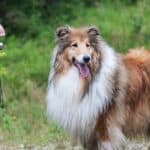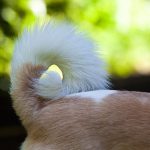
Although it seems hard to believe, dog dreams are very similar to those of humans. In fact, this is not surprising. From a structural point of view, in fact, a dog’s brain is quite similar to that of a person.
The involuntary nocturnal movements of dogs have long aroused the curiosity of researchers around the world. This is why some have decided to monitor the dreams of dogs through real scientific investigations. A series of studies carried out thanks to data collected through electroencephalograms and other clinical tests.
The results show that dogs dream . Also, they can have nightmares. The symptoms of this brain activity are visible: watch your dog carefully and you will notice it. Some wiggle their paws, others clench their jaws or even bark. Still others simply move their eyes behind closed lids.
What do dogs dream about?
It is impossible to know exactly what dog dreams are. However, the maps drawn by the encephalograms provide researchers with a number of interesting elements. First of all, these representations resemble, and not a little, those generated by the human mind. That is why it can be inferred that the content of canine dreams is similar to that of humans.
It can be assumed that when a dog flaps his legs, he is dreaming of running, playing or hunting . Sometimes the jaws are activated, as if to simulate a meal, perhaps a real dream banquet . If he exhibits pain and even aggression, your dog is probably the victim of a nightmare.
It is also known that, like us humans, dogs during rest consolidate their experiences and learnings in their memory . This means that the dog dream not only has a restoring function, but also a reorganization of the data in the brain .
The stages of sleep in dogs
Many believe that during sleep, major brain functions decrease. However, the opposite happens and this applies to both humans and dogs. Indeed, certain brain activities increase . A fact that occurs during the first phase of sleep, called the “slow wave phase” or SWS (Slow Wave Sleep).
In dog dreams, this first phase is interrupted several times by the REM (Rapid Eyes Movement) stages , which takes its name from the rapid movement of the eyes. During this phase, the brain dynamics grow until they multiply. It is at this stage that the dog begins to dream .
It will therefore be possible to notice some movements, legs, jaw or eyes, which experience the intense brain activity in the dream . In deep sleep , your four-legged friend’s brain is working harder than it does when awake.
Special features of dog dreams
Not all dogs dream the same way. Science has shown that the size of the animal is a determining factor. In fact, small dogs dream more and more intensely . Furthermore, puppies have more dreams and their nocturnal activity is greater than that of adult dogs.
- A poodle dreams every 10 minutes.
- A Golden Retriever dreams about every 90 minutes.
Going back to the puppies, everything seems to indicate that they have more dreams because they are in the development stage. This means that they are gaining a lot of new knowledge and a lot of new experiences. Therefore, the brain has more information to process at night.
A discontinuous sleep
As we have seen, therefore, the sleep of dogs is divided into various phases. They are not constantly only in a single dream phase (REM), but go through various moments. For example, if your dog has been sleeping for eight hours, his ‘dreaming’ phase will have been only a third .
Like the wolf , the dog alternates between sleeping and waking moments. It is the inheritance of an ancient predator that has however got used to following the habits of human masters. Typically, a dog sleeps for 5 to 20 minutes with waking breaks of 4 to 5 minutes. During the night, this cycle continues seamlessly.
This trait is due to the fact that dogs, even though they live with humans, retain a hunter’s genetics . Their instincts force them to remain in a perennial state of vigilance. To us it may seem like something stressful, but it is the only form these beautiful animals have, to control the territory day and night.
It is best not to wake them up
However, in order for you to rest satisfactorily, it is important to respect your dog’s sleep . As masters, it is your responsibility to take care of their physical and mental health: allow them to rest without being disturbed.
In fact, a normally friendly and obedient dog can become aggressive if awakened. Abruptly interrupting rest can even cause palpitations . In case he feels fear or dread, he may be prone to attack or bite.
A risk that can arise if this occurs during REM or deep sleep (when the dog makes small sounds or makes involuntary movements). If you notice these behaviors and the animal’s breathing is regular and slow, let it rest . You will play with him at another time.






